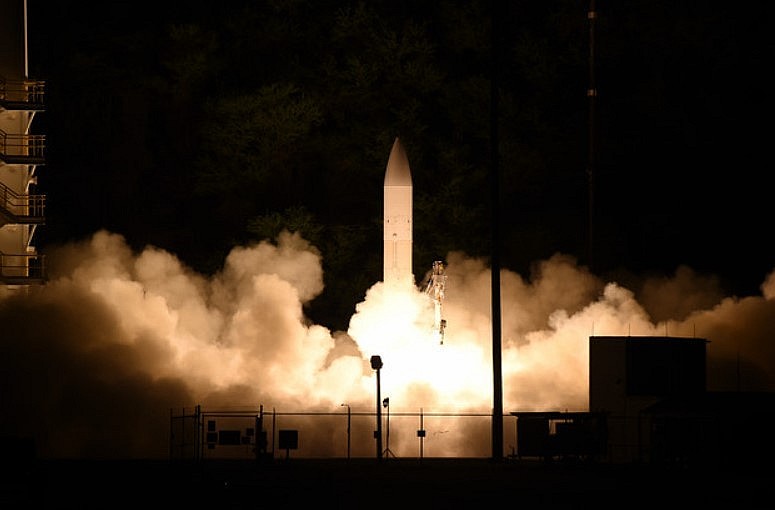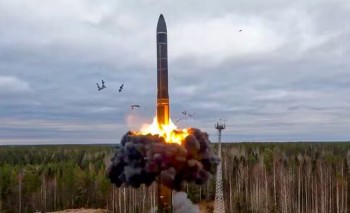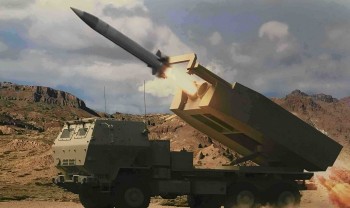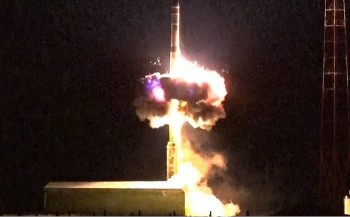What is Oreshnik - The Hypersonic Ballistic Missile That 'Impossible to Shoot Down?'
 |
| Russia launched hypersonic missiles |
This powerful weapon was reportedly used in a non-nuclear attack on Dnepropetrovsk, Ukraine, signaling a significant escalation in modern warfare capabilities. President Vladimir Putin has hailed Oreshnik as a missile that "cannot be intercepted," emphasizing its cutting-edge design and devastating potential.
This article explores what is known about the Oreshnik missile, including its strength, range, destructive power, and implications for global security.
 What Makes an ICBM Deadly? Nuclear Warheads, and Catastrophic Impact What Makes an ICBM Deadly? Nuclear Warheads, and Catastrophic Impact |
What is the Oreshnik Missile?
Oreshnik is a newly unveiled hypersonic ballistic missile developed by Russia. It combines the speed and maneuverability of hypersonic weapons with the long-range precision of ballistic missile systems, making it one of the most advanced weapons in Russia's arsenal.
1. Hypersonic Capabilities
- Speed: Oreshnik travels at speeds exceeding Mach 5 (more than 6,100 km/h or 3,800 mph), potentially reaching Mach 10 or higher. This speed drastically reduces the time for interception.
- Maneuverability: Unlike traditional ballistic missiles, Oreshnik can change its trajectory mid-flight, making it nearly impossible for missile defense systems to predict and intercept its path.
2. Advanced Technology
- Glide Vehicle: The missile likely incorporates a hypersonic glide vehicle (HGV) that separates from the booster and glides through the atmosphere at extreme speeds.
- Stealth Features: Oreshnik is designed to evade radar detection with advanced materials and low visibility, enhancing its survivability against modern air defenses.
3. Deployment Context
Oreshnik is believed to be a part of Russia's broader strategy to maintain technological superiority in missile warfare, particularly in the context of increasing tensions with NATO and the ongoing conflict in Ukraine.
Video of the moment a Russian hypersonic missile crashed into the Ukrainian city of Dnipro:
Strength and Power of Oreshnik
1. Destructive Power
Oreshnik is designed to deliver both nuclear and non-nuclear payloads with devastating precision and impact. Its destructive capabilities are rooted in several key factors:
- Explosive Yield: While specific details about the warhead's size remain classified, conventional Oreshnik strikes are believed to deliver payloads capable of penetrating hardened structures like bunkers and fortified command centers.
- Kinetic Energy Impact: At hypersonic speeds (Mach 10 or higher), even a non-explosive warhead could generate massive destruction upon impact due to sheer kinetic force.
- Blast Radius: For conventional warheads, the radius of destruction is estimated to cover several kilometers, making it effective against concentrated military targets or urban infrastructure.
- Nuclear Potential: Oreshnik can also be equipped with nuclear warheads, potentially delivering a yield in the hundreds of kilotons, enough to destroy entire cities or critical military installations.
2. Advanced Targeting Systems
Oreshnik uses cutting-edge GPS and inertial navigation systems for precision targeting:
- Near-Zero Circular Error Probable (CEP): This means the missile can land within a few meters of its target, ensuring pinpoint accuracy.
- Moving Targets: Advanced sensors and guidance algorithms allow Oreshnik to adjust its trajectory mid-flight, making it capable of hitting moving ships, convoys, or other dynamic targets.
Video simulating the attack mechanism of Russian hypersonic missile, Oreshnik:
Range of Oreshnik
1. Intercontinental and Regional Reach
While exact figures are not officially confirmed, defense analysts estimate Oreshnik’s range to be between 2,500 kilometers and 5,000 kilometers (1,550–3,100 miles). This places it in a class of medium-to-intercontinental ballistic missiles, capable of striking targets across continents.
- Strategic Range Capabilities:
- Oreshnik can be launched from within Russian territory to strike targets as far as Western Europe, the Middle East, or even parts of Asia.
- The missile's range provides flexibility for both offensive operations and strategic deterrence.
2. Dual-Platform Launch Capabilities
Oreshnik is likely designed for launch from multiple platforms:
- Ground-Based Systems: Mobile launchers or fixed silos within Russia, making it adaptable to strategic scenarios.
- Naval Platforms: Though unconfirmed, Oreshnik may eventually be launched from submarines, extending its reach further across oceans and enabling stealth attacks.
3. Flight Time
Due to its hypersonic speed (exceeding Mach 10), Oreshnik drastically reduces the time required to hit its target:
- A missile launched from Moscow could reach targets in Western Europe in under 10 minutes.
- This rapid response time minimizes the enemy’s ability to prepare countermeasures, significantly enhancing its operational effectiveness.
Interception: Is Oreshnik Truly Unstoppable?
President Putin has boldly declared that Oreshnik is "interception-proof," a claim rooted in its advanced engineering and the limitations of existing missile defense systems.
1. Speed and Maneuverability
- Hypersonic Velocity: At Mach 10 or higher, Oreshnik can cover over 12,000 kilometers per hour (7,500 mph), leaving little time for detection and interception.
- Unpredictable Trajectory: Unlike traditional ballistic missiles, which follow a predictable parabolic path, Oreshnik can maneuver mid-flight, making it difficult for radars and interceptors to lock onto its course.
2. Overcoming Missile Defense Systems
Oreshnik’s design specifically counters the most advanced missile defense systems:
- THAAD (Terminal High Altitude Area Defense): U.S. systems like THAAD are optimized for high-altitude interceptions, but Oreshnik’s variable trajectory and glide capabilities render such defenses largely ineffective.
- Patriot Systems: While Patriot missile systems are effective against some ballistic missiles, they are ill-equipped to track and intercept hypersonic targets like Oreshnik.
- Saturation Tactics: Oreshnik may be deployed alongside decoys or in large salvos, overwhelming missile defense networks.
3. Stealth and Countermeasures
- Low Radar Cross-Section: Oreshnik is built with radar-absorbing materials and a compact design, making it difficult to detect during the boost and midcourse phases.
- Electronic Countermeasures (ECM): It may employ ECM systems to jam or confuse enemy radars, further enhancing its survivability.
4. Theoretical Vulnerabilities
While Oreshnik is formidable, no system is truly invincible:
- Space-Based Tracking: Advanced satellite networks could potentially detect its launch and relay early warning data.
- Directed Energy Weapons (DEWs): Emerging technologies like high-power lasers might intercept hypersonic missiles in the future, though such systems are still experimental.
Comparison with Other Hypersonic Missiles
Oreshnik joins a growing list of hypersonic weapons being developed by major military powers, including the United States and China.
1. Russia’s Hypersonic Arsenal
- Avangard: A hypersonic glide vehicle capable of carrying nuclear warheads.
- Kinzhal: An air-launched hypersonic missile used extensively in the Ukraine conflict.
2. U.S. Hypersonic Efforts
- AGM-183 ARRW: The U.S. is developing air-launched rapid response weapons to counter hypersonic threats.
- Challenges: U.S. hypersonic programs are still in development, with operational deployment lagging behind Russia.
3. China’s Hypersonic Developments
- DF-ZF: A hypersonic glide vehicle integrated into China’s missile programs.
- Global Reach: China’s systems emphasize long-range strikes and regional dominance.
Conclusion
The Oreshnik hypersonic ballistic missile represents a new era in missile technology, combining unparalleled speed, precision, and range. Its recent deployment in Ukraine underscores its potential as a game-changing weapon, while President Putin’s claims of its interception-proof design highlight its significance in global military strategies.
As hypersonic weapons continue to shape the landscape of modern warfare, Oreshnik exemplifies both the technological advancements and the escalating risks associated with these powerful tools. The global response to its deployment will likely define the next chapter in the evolving balance of power on the world stage.
 What is ATACMS? The Long-Range U.S. Missile Empowering Ukraine Against Russia What is ATACMS? The Long-Range U.S. Missile Empowering Ukraine Against Russia President Biden has authorized the first use of U.S.-supplied long-range missiles by Ukraine for strikes inside Russia. This article explores what ATACMS is, its military ... |
 The Threat of World War Three from Ukraine’s Use of Long-Range Missiles The Threat of World War Three from Ukraine’s Use of Long-Range Missiles In this analysis, we will explore the geopolitical and military implications of this escalation, examine the rhetoric and potential responses from Russia, and assess whether ... |
 The Anti-personnel Landmines Sent to Ukraine: Banned by Over 150 Nations, Approved by the U.S. The Anti-personnel Landmines Sent to Ukraine: Banned by Over 150 Nations, Approved by the U.S. On November 20, 2024, U.S. Defense Secretary Lloyd Austin announced that the Biden administration would permit Ukraine to utilize American-supplied anti-personnel landmines in its defense ... |
 The 10 Most Devastating ICBMs on the Planet: From Sarmat to Minuteman The 10 Most Devastating ICBMs on the Planet: From Sarmat to Minuteman Chinese media outlets have conducted a poll and compiled a ranking of the top 10 intercontinental ballistic missiles (ICBMs) currently regarded as the most powerful ... |

























